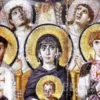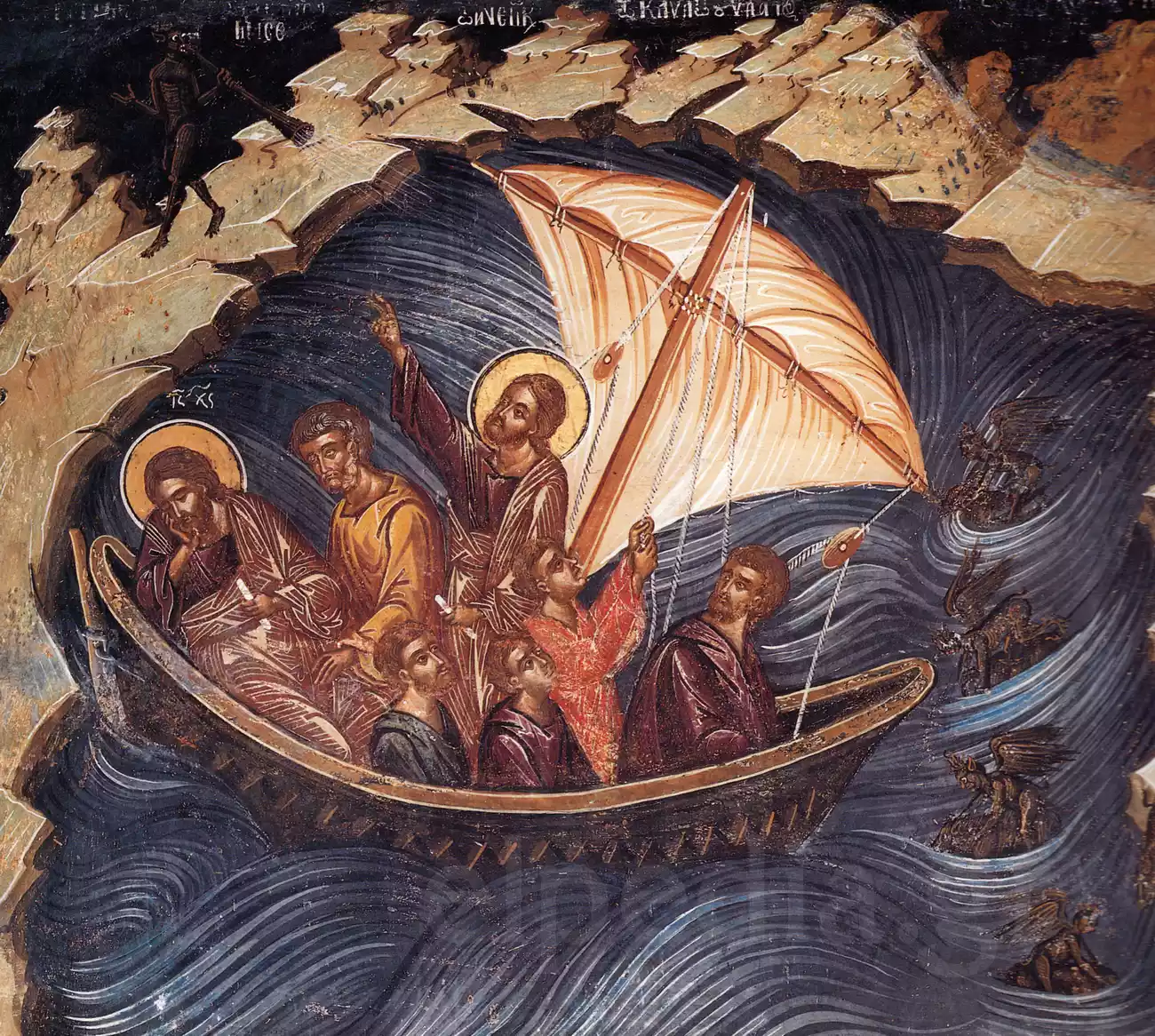
The dramatic scene where Christ rebukes the wind and the sea, a masterpiece of the 16th century at the Monastery of Philanthropinon in Ioannina, full of theological symbolism.
Title: Christ Rebukes the Wind and the Sea
Artist: Unknown (possibly influenced by a Cretan model)
Type: Fresco
Date: 1531/32 (;)
Dimensions: Unknown (as part of a fresco ensemble)
Materials: Natural colors on wet plaster (fresco)
Location: Katholikon of the Monastery of Philanthropinon, Island of Ioannina (North wall)
Divine Intervention in the Stormy Sea
In the serene environment of the Island of Ioannina, within the walls of the historic Monastery of Philanthropinon, unfolds a scene of unparalleled divine power and artistic skill. The fresco depicting Christ rebuking the wind and the sea, likely created around 1531/32, is a brilliant example of 16th-century post-Byzantine painting. This representation is not isolated but harmoniously fits into the extensive Christological cycle that adorns the original decoration of the main church, specifically in the section of miracles on the north wall. It captivates the eye and the soul, narrating the well-known biblical account where Jesus, after the plea of his terrified disciples, calms a fierce storm on the Sea of Galilee, revealing his omnipotence even over the elements of nature. The scene, filled with intensity and symbolism, is rendered with vibrancy and remarkable attention to detail, revealing the influence of 15th-century Cretan models, such as those found in works depicting maritime miracles, like that of Saint Fanourios by the Cretan painter Angelos (Chatzidakis).
The Monastery of Philanthropinon and Its Artistic Wealth
Nestled on the picturesque Island of Lake Pamvotis, the Monastery of Philanthropinon, also known as the Monastery of Saint Nicholas of Spapanos, is one of the most significant monastic complexes in Epirus, with a rich history and invaluable artistic heritage. Its founding is placed in the 13th century, but its current form and, mainly, its impressive fresco decoration were shaped during the 16th century. The katholikon of the monastery, initially a single-aisled church that was later expanded with the addition of a narthex, is literally covered with frescoes belonging to at least three distinct painting phases within the 16th century. These frescoes cover a wide thematic range, including scenes from the Old and New Testament, the lives of Saints, as well as representations of ancient Greek philosophers, an element that underscores the unique spiritual character of the monastery. Within this rich iconographic program, the scene where Christ rebukes the wind and the sea holds a prominent position on the north wall of the main church, as part of the extensive Christological cycle and specifically the section of miracles, belonging to the initial phase of decoration (around 1531/32).
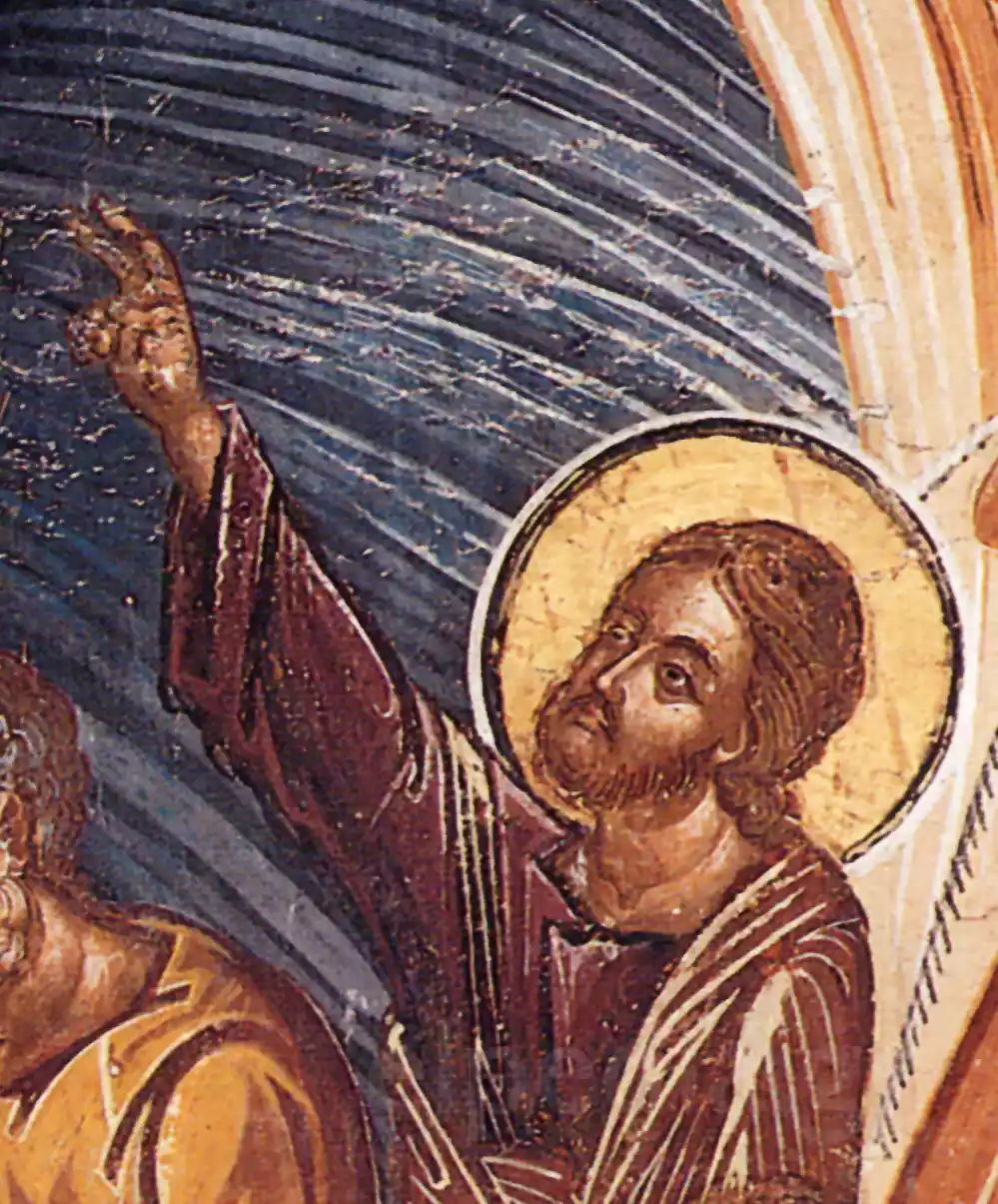
Close-up of the figure of Christ as he raises his hand, imposing calm on the troubled sea. The divine authority captured in the fresco.
Iconographic Analysis of the Storm Scene
The fresco at the Monastery of Philanthropinon dramatically captures the moment of divine intervention. The composition is dynamic and organized around the boat struggling with the raging waves.
The Composition and Central Figures
The focal point of the representation is, of course, the figure of Christ. Initially, we see him sleeping in the stern, unperturbed amidst the general turmoil, symbolizing divine calm in the face of chaos. Next to him, the Apostle Peter, with evident anxiety on his face, nudges him to wake him up, expressing human weakness and fear in the face of nature’s wrath. Subsequently, the central action shifts as Christ, having risen, stands imposing in the middle of the boat. With his right hand raised in a gesture of authority and rebuke, he commands the elements of nature to submit. His posture is calm yet decisive, exuding divine authority. The other disciples are depicted crowded in the small boat, their expressions ranging from terror and despair to awe and surprise at the miracle unfolding. The boat itself, designed in detail, although simple in construction, becomes the field where human disbelief clashes with divine omnipotence. The sense of movement and instability is enhanced by the tilt of the boat and the way it appears ready to capsize.
The Depiction of Nature and the Supernatural
The rendering of the sea is particularly impressive. The unknown artist uses bold, almost spiraling brushstrokes and dark blues and grays to convey the ferocity of the waves that seem to engulf the boat. The sea is not merely a backdrop but a living protagonist of the scene, a hostile force threatening human lives. Equally unique is the personification of the wind. On the barren, rocky shores framing the scene, a dark, demonic figure is discernible. This “evil demon,” as described, blows through a long horn, sending the destructive whirlwind towards the boat. This depiction connects the storm not only with natural forces but also with the forces of evil, which Christ is called to conquer. The contrast between the fury of nature and the divine calm (calm) imposed by Christ with his word is the central dramatic element of the representation (Nouis). The scene conveys the sense that order is restored in the universe through divine intervention.
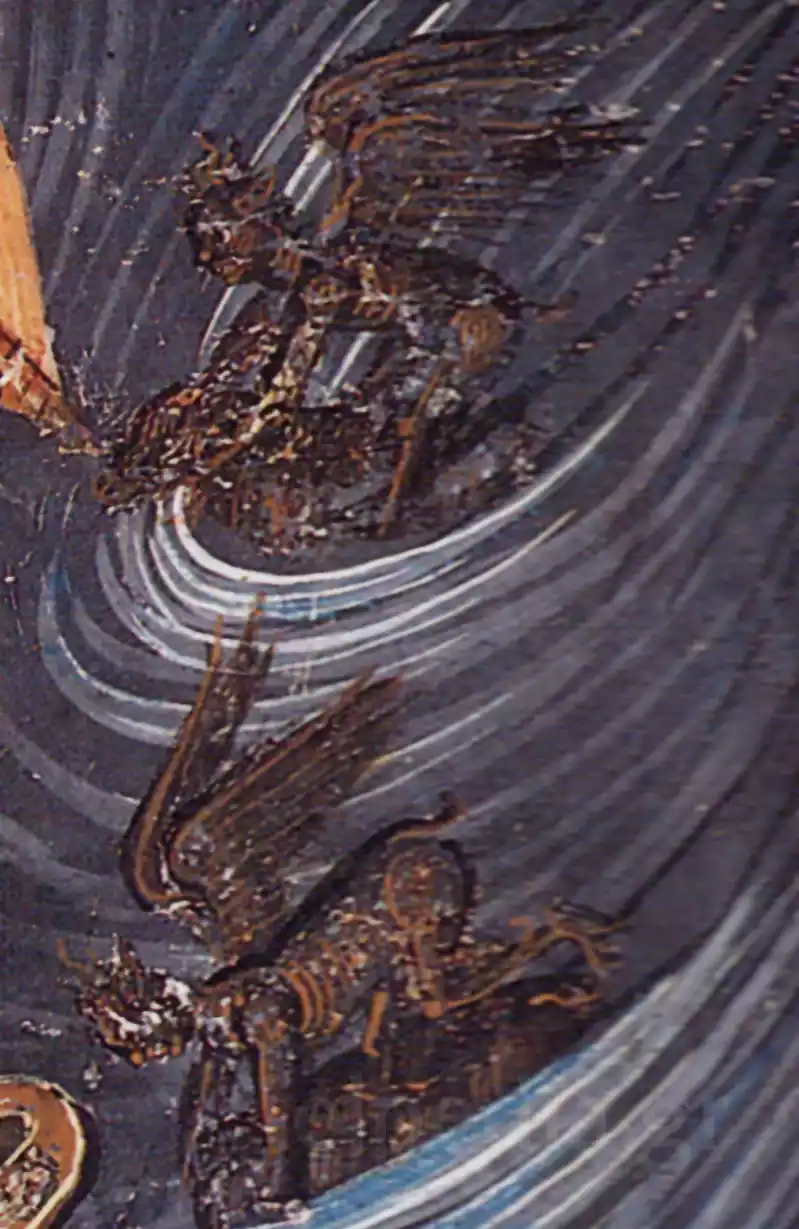
The unique personification of the wind as a demonic figure blowing the horn, an element that adds an allegorical dimension to Christ’s battle with chaos.
Technique and Artistic Influences
The fresco of Christ rebuking the sea at the Monastery of Philanthropinon is characterized by a vivid narrative tone and remarkable accuracy in details, elements that make it particularly appealing (Garidēs and Paliouras). The artist demonstrates great skill in rendering the figures, the garments, and, above all, the turbulent sea. The brushstrokes, although not discernible with absolute clarity due to the nature of the fresco and the wear of time, appear dynamic and confident, especially in the depiction of the waves and the folds of the clothing. The color palette is rich, with cool colors (blue, gray) dominating the sea and the shores, contrasting with the warmer colors (red, yellow, brown) used for the figures and the boat, thus creating visual tension. The texture of the materials, such as the wood of the boat and the fabrics of the garments, is rendered schematically yet convincingly.
Standing (even mentally, through the image) in front of this fresco, one feels the power of the moment. Its position on the north wall of the relatively low-lit katholikon would enhance the drama, with the candlelight playing on the figures and the waves. The scale of the representation, integrated into a whole, would make it immediately perceptible and imposing to the 16th-century faithful. The technique of the scene is thought to hark back to Cretan models of the 15th century. The liveliness, narrativity, and the way the sea and the figures are rendered remind one of works from the Cretan School, such as the image of the miracle of Saint Fanourios by the painter Angelos. Similar depictions of the same theme are found in other significant monasteries, such as in the Monastery of Saint Nicholas of Anapausas at Meteora (work of Theophanes the Cretan, 1527) and in the Monastery of Megistis Lavras at Mount Athos, confirming the circulation of artistic ideas and models in the Greek territory during the post-Byzantine period.
Theological Symbolisms and Messages
Beyond its artistic value, the fresco at the Monastery of Philanthropinon is charged with deep theological content. The central message is the revelation of the divinity of Christ and his absolute dominion over creation. The elements of nature, the wind and the sea, which instill terror in people, obey his word, proving that He is the Creator and Lord of all. The contrast between the sleeping Christ and the fury of the storm underscores the difference between divine calm and human turmoil. Christ’s sleep is not weakness but a sign of trust and control over the situation. The disciples’ reaction, characterized as “little faith” in the Gospels, highlights human weakness in fully grasping divine power, even for those closest to Christ. The miracle aims not only to save them from physical danger but primarily to strengthen their faith. The boat, amidst the storm, serves as a timeless symbol of the Church navigating through the difficulties and trials of the world, always having Christ as its helmsman, who can bring peace even in the fiercest storms. The personification of the wind as a demon adds an additional level of symbolism, presenting Christ as the victor not only over natural forces but also over the dark spiritual forces that oppose God’s plan.
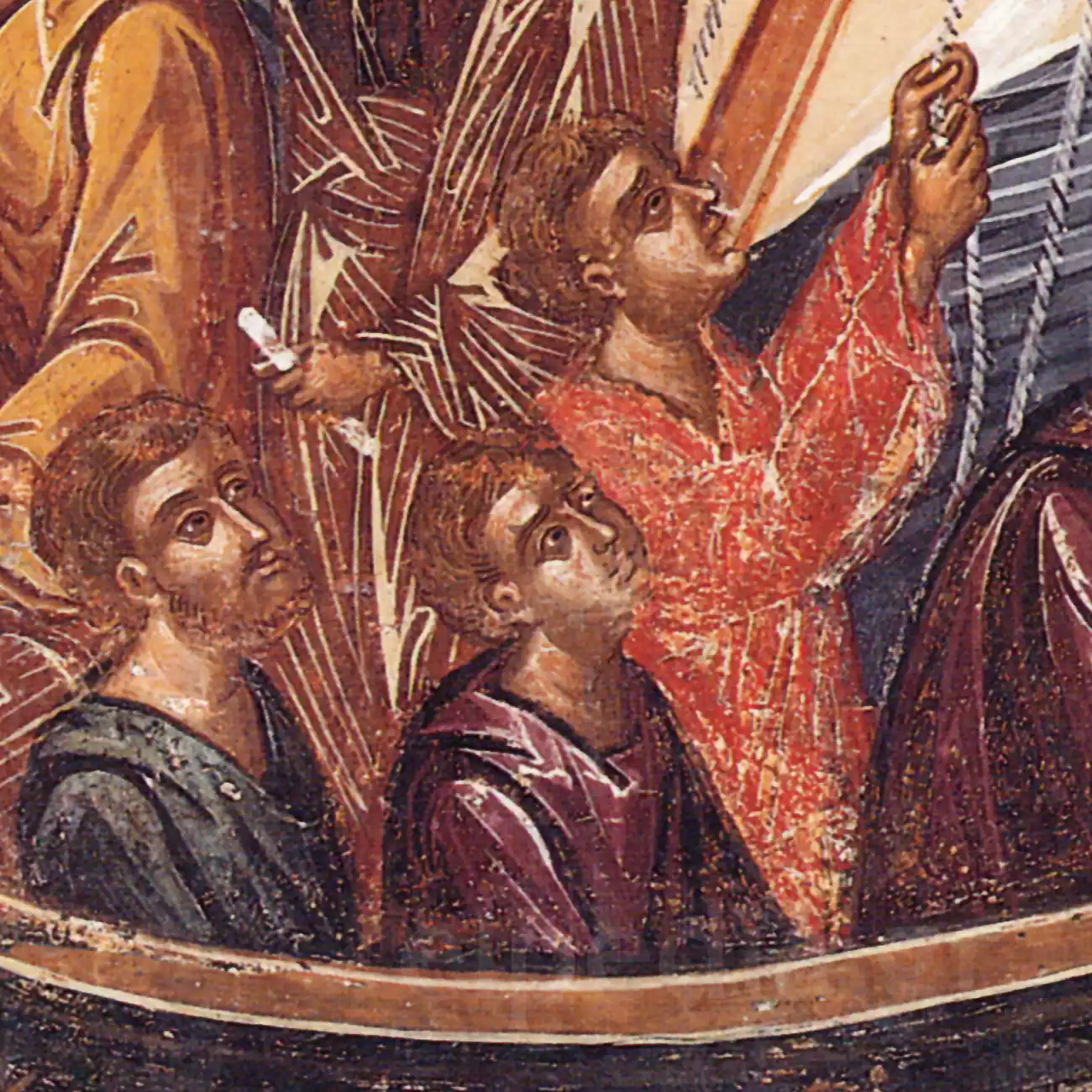
The disciples, with evident fear and hope, crowd into the boat that is tossed by the waves. A vivid depiction of human weakness.
Different Interpretations & Critical Assessment
The study of the frescoes of the Monastery of Philanthropinon has engaged many researchers of Byzantine and post-Byzantine art. Scholars such as Myrtali Achimastou-Potamianou have thoroughly analyzed the various phases of the painting and their stylistic peculiarities, linking the first phase, to which the “Storm” belongs, with workshops of the mainland school that receive strong Cretan influences. Manolis Chatzidakis, referring to the corresponding scene of Theophanes at Meteora, provides comparative data for the evolution of the iconography of the theme. However, there are also different approaches regarding the precise dating of certain sections or the identity of the artists, as the inscriptions are often incomplete. The relationship with specific Cretan models and the degree of originality of the painters of Epirus remain fields of ongoing discussion in the academic community.
Conclusion
The fresco “Christ Rebukes the Wind and the Sea” at the Monastery of Philanthropinon is not merely an illustration of a biblical narrative but a complex work of art that condenses theological messages, artistic influences, and the spirituality of an entire era. The drama of the composition, the vibrancy of the colors, and the expressiveness of the figures magnetize the viewer, transporting them to the center of the storm, but also to the divine calm that follows Christ’s intervention. It serves as a powerful reminder of the omnipotence of the divine and the need for faith amidst the difficulties of life. The study of it allows us to appreciate the rich artistic tradition of post-Byzantine Greece and to understand more deeply how art served theology and faith. A visit to the Monastery, even through these pages, offers a unique experience of reverence and aesthetic enjoyment.
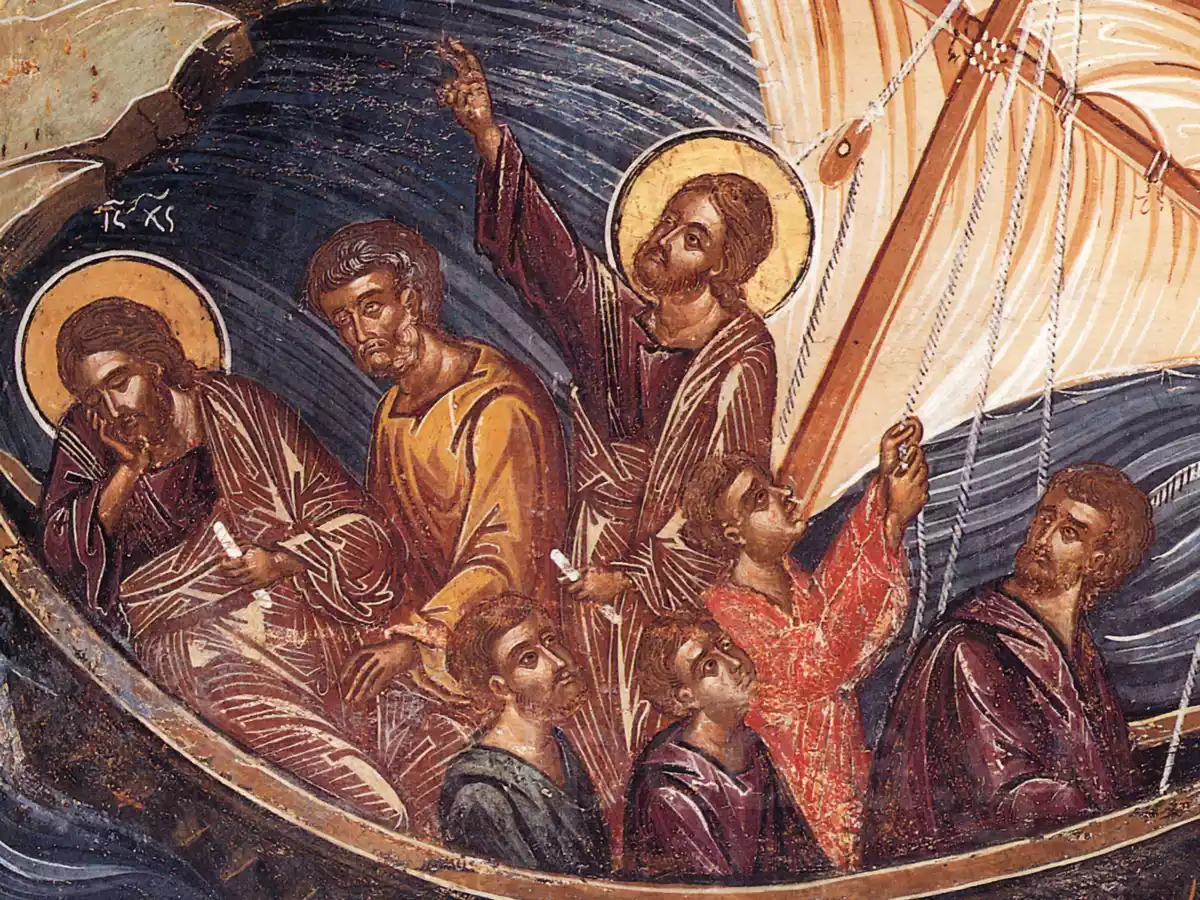
Frequently Asked Questions
Where is the fresco “Christ Rebukes the Wind and the Sea” located?
This particular fresco is located in the katholikon of the Monastery of Philanthropinon (Saint Nicholas of Spapanos), which is built on the Island of Lake Pamvotis, in Ioannina. It adorns the north wall of the main church and is part of the broader Christological cycle, in the section dedicated to the miracles of Jesus, depicting the moment when Christ rebukes nature.
What is the main theme of the representation where Christ calms the storm?
The main theme is the manifestation of Christ’s divine omnipotence over the elements of nature. While his disciples are terrified by the storm, Jesus, with a word, imposes calm on the wind and the sea. The work emphasizes God’s sovereignty over creation and the message of faith that overcomes fear.
To which artistic period does the fresco of Jesus calming the sea belong?
The fresco dates to around 1531/32 and belongs to the first phase of post-Byzantine painting at the Monastery of Philanthropinon, within the 16th century. Its technique bears strong influences from the Cretan School of the 15th century, as seen in the liveliness of the narrative and the accuracy in the details of the scene where Christ rebukes the elements.
How is the wind depicted in the fresco of the Monastery of Philanthropinon?
In this fresco, the wind is not merely represented as a natural phenomenon but is personified in a particularly symbolic way. It is depicted as a dark, demonic figure on the rocky shores, blowing through a long horn, directing the whirlwind towards the boat. This depiction connects the storm with the forces of evil that Christ conquers.
Why is the scene where Christ rebukes nature considered significant?
This scene is theologically significant because it reveals the divine nature of Christ and his authority over all creation. For the faithful, it is a powerful reminder that faith in God can bring peace to the “storms” of life. Artistically, the representation at the Monastery of Philanthropinon is noteworthy for its dynamic composition and its connection to the Cretan School.
Bibliography
- Archeion Euvoïkōn meletōn. Vol. 32, 1997.
- Archaiologikon deltion. Vols. 58-64, Ministry of Culture and Sciences, General Directorate of Antiquities and Restoration, 2003.
- Garidēs, Miltos, and Athanasios D. Paliouras. Monasteries of the Island of Ioannina: Painting. Translated by Cox & Solman, Ekdotike Athenon, 1993.
- Nouis, Antoine. L’aujourd’hui de l’évangile: Lecture actualisée de textes bibliques. Éditions Olivétan, 2003.
- Papadopoulou, Varvara N., and Aglaia L. Tsiara. Images of Artas: The ecclesiastical painting in the region of Artas during the post-Byzantine period. Ministry of Culture, 12th Ephorate of Byzantine Antiquities, 2008.

